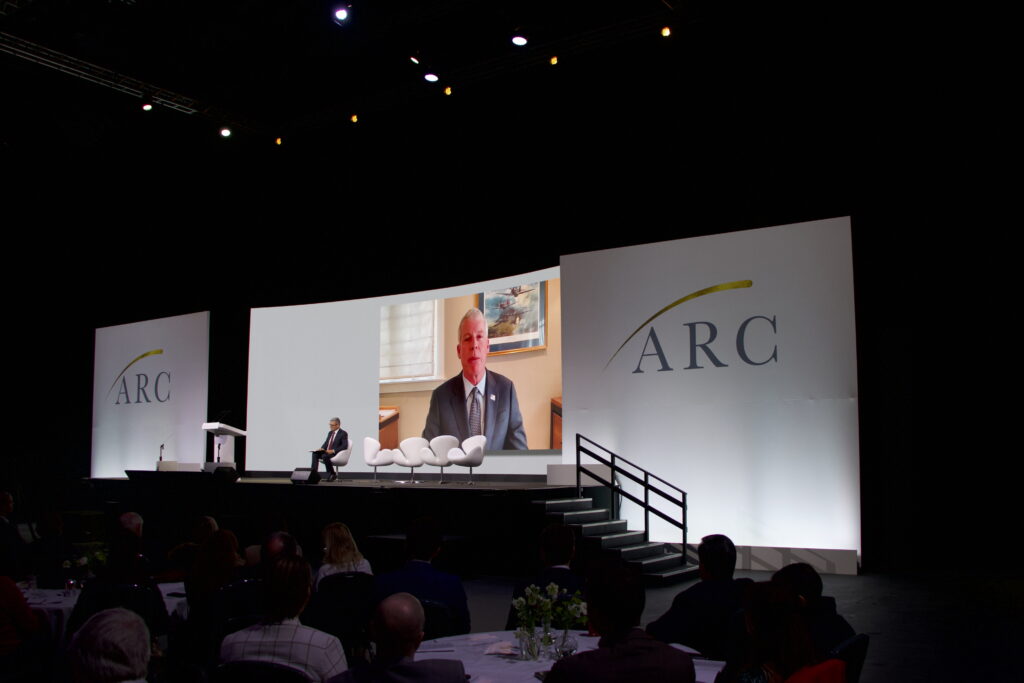Near the end of 2018, the U.S. Department of Energy (DOE) hired the leading promoter within academia of a massive and multi-faceted petrochemical complex proposed for West Virginia. A month later, the agency issued a report favoring the construction of such a complex.
On November 9, the Energy Department’s National Energy Technology Laboratory (NETL) named as its new director former West Virginia University Professor Brian Anderson.
NETL, which spearheads federal energy-related research and development (R&D) efforts, is currently deciding whether to grant $1.9 billion in R&D money toward building out the proposed petrochemical complex, known as the Appalachian Storage Hub.
The storage hub, say its proponents, will compete with the Gulf Coast-based petrochemical hub of Mont Belvieu and perhaps even have a pricing index for traders.
Those alarmed by the prospect of the hub point to the fact that towns along the Gulf of Mexico have higher rates of cancer. Some call that dense stretch of petroleum refineries and petrochemical plants near the Gulf the “Petrochemical Corridor,” while locals call it “Cancer Alley.”
Critics also say the project could further drive up demand for hydraulic fracturing — or “fracking” — of natural gas within the nearby Marcellus Shale and Utica Shale basins.
As DeSmog has reported in an ongoing investigative series titled “Fracking for Plastics,” the Appalachian hub is just one piece of a broader plan for the petrochemical industry’s ambitions to transform the Appalachian region into a cutting-edge, fossil-fueled storage and refining epicenter. That could spell serious consequences for worsening the impacts of climate change.
Read Fracking for Plastics, a DeSmog investigation into the proposed petrochemical build-out in the Rust Belt and the major players involved, along with the environmental, health, and socio-economic implications.
Report to Congress
Just a few short weeks after announcing Anderson’s hiring, the Energy Department published a report titled, “Report to Congress: Ethane Storage and Distribution Hub in the United States,” and mandated by the Energy and Water Development Appropriations Bill of 2017.
“The Department is directed to issue a report on the feasibility of establishing an ethane storage and distribution hub in the United States, given the increased production of natural gas liquids (NGLs) from shale developments and recognizing that ethane is the largest component of those NGLs,” the 2017 bill reads. “The report should examine potential locations, economic feasibility, economic benefits, geologic storage capabilities, above ground storage capabilities, infrastructure needs, and benefits to energy security.”
Moving NETL’s Needle
Anderson, during his tenure at West Virginia University, founded and headed the school’s Energy Institute. In the DOE press release announcing his new position with NETL, he did not mention his past promotion of the petrochemical hub — which in large part is represented by an $83 billion partnership between West Virginia and China — though the release does call out his involvement in “pav[ing] the pathway” for a partnership between the two countries.
“I am honored and humbled at the opportunity to serve as the director of the National Energy Technology Laboratory (NETL),” said Anderson. “The work that is being conducted at NETL is critical to advancing technologies that will transform the use and production of our nation’s vast coal, natural gas, and oil resources to protect our environment and enhance our nation’s energy security. I look forward to working with the talented and dedicated team at NETL to continue the lab’s efforts as the gold standard in advancing energy research and development.”
While Anderson did not mention his ties to the proposed petrochemical complex — which include serving as a former executive for the Appalachian Development Group, the firm which applied for the $1.9 billion Energy Department grant his office is now considering — he did receive questions about his work promoting the hub from the Pittsburgh Post-Gazette.
“As the Appalachian storage hub keeps moving forward,” he told the newspaper, “I’m certainly replaceable. It’s something that I still support, but I’m not involved in any of that anymore.”
But just a month after beginning his federal job, Anderson nearly reneged on his statement about removing himself from involvement.
Credit: West Virginia Energy Infrastructure Summit
A preliminary schedule for the January 10, 2019 West Virginia Energy Infrastructure Summit lists him as one of the speakers, slotted to speak about energy infrastructure immediately after Steve Hedrick, CEO of the Appalachian Development Group.
Hedrick, who spoke at the forum about the petrochemical hub, is currently under investigation by a special counsel, former U.S. Attorney Mike Carey. West Virginia Governor Jim Justice hired Carey to investigate Hedrick’s potential use of state funds when he joined an official delegation to China. The investigation will probe whether he used the trip as a means of enriching himself and his business.
Ultimately, Anderson did not speak at the January event and did not respond to a request for comment for this story.
DOE spokeswoman Kelly Love told DeSmog that the agency did a comprehensive background check and cleared Anderson, though he will also recuse himself from issues in which he carries a conflict of interest.
“The Department follows all federal laws and ethics requirements regarding onboarding new employees,” explained Love. “The employee in question has been counseled regarding recusal from matters relating to past employers.”
Report Unveiled to Shadow Lobby
The DOE’s report touting the potential for a fossil-fueled petrochemical hub in Appalachia was unfurled where else but in the belly of the beast of the oil and gas industry. That is, at the annual meeting in Washington, D.C., for the National Petroleum Council, a body overseen by the Energy Department and created in 1946 under President Harry Truman.
The Petroleum Council, in essence, acts as a collective of oil and gas industry executives who distill their priorities during meetings in Washington alongside top Energy Department officials. The council’s office sits on K Street, the heart of lobbying within the nation’s capital. One of the most recent examples of its work, produced during the Obama era, was a report calling for greenlighting offshore drilling in the Arctic.
“There is an incredible opportunity to establish an ethane storage and distribution hub in the Appalachian region and build a robust petrochemical industry in Appalachia,” U.S. Secretary of Energy Rick Perry said at the National Petroleum Council meeting while introducing the report on the potential petrochemical hub.
“As our report shows, there is sufficient global need, and enough regional resources, to help the U.S. gain a significant share of the global petrochemical market. The Trump administration would also support an Appalachia hub to strengthen our energy and manufacturing security by increasing our geographic production diversity.”
The Energy Department report explicitly points to the prospective Appalachian petrochemical hub as a complement to the one along the Gulf Coast.
“[M]arket analysis from the report emphasizes that the development of an Appalachian hub may offer a competitive advantage for the U.S. to gain global petrochemical market share while not being in conflict with Gulf Coast expansion,” explains the press release outlining the paper. “The report explains that a new Appalachian hub would enhance the geographic diversity of the vital U.S. petrochemical industrial sector, supporting U.S. economic security.”
While the report outlines the broad contours of a potential large-scale petrochemical storage and refining market — refining which would transpire at what the industry calls “cracking” plants — some West Virginia and Ohio congressional delegates have called for additional studies to further detail what such a build-out would look like.
These calls have come through the sponsorship and introduction of the Appalachian Ethane Storage Hub Study Act. The bill, which has yet to move far beyond the introduction phase, has received federal lobbying support from Shell and the American Chemistry Council, the former of which is building a major cracking facility to produce plastics in Pennsylvania and the latter is a collective of oil, gas, and petrochemical companies using their considerable lobbying prowess to push for the hub’s creation.
The day that the DOE released its report, the American Chemistry Council released a glowing press statement about its contents.
“We welcome DOE’s report, which affirms that the Appalachian region could become a major petrochemical and plastic resin-producing zone,” said the American Chemistry Council in its press release. “Proximity to a world-class supply of feedstocks and to the manufacturing markets of the Midwest and East Coast have already led several companies to announce investment projects, and there is potential for a great deal more. It’s an exciting opportunity for the region and our nation.”
Deal Proceeds, Critics Decry
When President Donald Trump first launched the ongoing trade war against China, some observers thought the impasse might lead to the demise of the storage hub. Those predictions, however, have not yet come to pass and Chinese powerbrokers have affirmed that the deal lives on.
“We and the West Virginia government, and other related companies, have always been extremely aggressive in pushing forward this project,” said Ling Wen, president and CEO of the state-owned company China Energy Investment, at a media briefing on the company’s earnings, according to the business publication S&P Global.
Though the billions of dollars in capital needed to create a petrochemical hub in Appalachia have yet to finalize, the Appalachian Development Group also has continued to march forward on the project. In August 2018, the company signed a $3.4 billion deal with the engineering firm Parsons Corporation to form a partnership and engineer the hub.
“Parsons is honored to have been selected by ADG [the Appalachian Development Group] as a partner on this critically important project that will ultimately support the economic and energy security needs of so many communities and citizens, including economic revitalization of the Ohio River Valley states,” Carey Smith, president of Parsons’ federal business unit, said in a press release about the deal.
Not everyone remains pleased with these developments. One such entity is Food and Water Watch, a Washington, D.C.-based advocacy group with chapters across the country, which opposes fracking and the creation of the Appalachian Development Hub.
“The proposed storage complex may be a profit bonanza for industry, but it is a pollution pitfall for communities and ecosystems of the Appalachian basin,” Food and Water Watch wrote in a September 2018 report titled “Another Petrochemical Sacrifice Zone.” “Converting the region into the second largest concentration of plastics and chemical manufacturing outside the highly polluted Gulf Coast will compound the Tri-State area’s already substantial exposure to industrial toxic emissions, while increasing plastic materials that largely end up polluting the earth’s oceans.”
Main image: Brian Anderson Credit: Provided by West Virginia University
Subscribe to our newsletter
Stay up to date with DeSmog news and alerts








